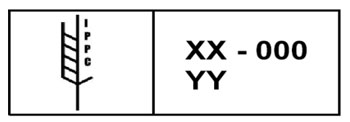What is ISPM 15?
International Standards for Phytosanitary Measures (ISPMs) form the basis for harmonising the application of phytosanitary measures in international trade and have been developed through a multilateral drafting and consultation process by Contracting Parties of the International Plant Protection Convention (IPPC). Australia and other World Trade Organisation (WTO) members are encouraged to establish national measures consistent with the ISPMs set by the IPPC.
ISPM 15 is the 'International Standards for Phytosanitary Measures Publication No. 15 (2019): Regulation of Wood Packaging Material in International Trade'. It is the international standard for regulating the movement of timber packaging and dunnage through international trade and aims to prevent the global spread of timber pests.
How does ISPM 15 apply to Australia’s biosecurity requirements?
The requirements outlined in ISPM 15 have been incorporated into the conditions for importing solid wood packaging materials into Australia. These are detailed in Australia’s Biosecurity Import Conditions (BICON) under the cases:
- ‘Timber and bamboo packaging’ for packaging imported as a commodity – e.g. a consignment of wooden pallets imported for use in Australia.
- ‘Non-commodity’ for packaging used to support other commodities – e.g. wooden pallets used to support a consignment of other goods.
Australia accepts solid timber packaging that is compliant with ISPM 15, but also offers alternative treatment options and will accept consignments of timber packaging that can meet the alternative requirements outlined in BICON.
How does Australia monitor compliance with these requirements?
As per the import conditions outlined in BICON and the department’s non-commodity information requirements policy, non-commodity timber in containerised cargo must be declared to the department and accompanied by appropriate documentation. This includes ISPM 15 compliance statements or evidence of alternative treatment.
The department also conducts random surveillance on all types of cargo to ensure that imported timber packaging import conditions have been met. Timber packaging that is found to be non-compliant will be sent for treatment, export or destruction at the importers expense.
What products does ISPM 15 apply to?
ISPM 15 applies to coniferous (softwood) and non-coniferous (hardwood) raw wood packaging material. This includes pallets, dunnage, crating, packing blocks, drums, cases, spools/reels, bulk heads, load boards, pallet collars and skids.
The following articles are considered low risk and are exempt from the provisions of the standard:
- wood packaging made entirely from thin wood (6 mm or less in thickness)
- wood packaging made wholly of processed wood material such as plywood, particle board, oriented strand board or veneer that has been created using glue, heat or pressure, or a combination thereof
- veneer peeler core
- barrels for wine and spirit that have been heated during manufacture
- gift boxes for wine, cigars and other commodities made from wood that has been processed and/or manufactured in a way that renders it free of pests
- sawdust, wood shavings and wood wool
- wood components permanently attached to freight vehicles and containers.
What is required to comply with ISPM 15?
For detailed information on how to comply with ISPM 15, see the IPPC ISPM 15 webpage. In summary, for timber packaging to comply with ISPM 15 it must:
- meet the ISPM 15 bark tolerance requirements; and
- have been subjected to an ISPM 15 approved treatment by an appropriately certified treatment provider or manufacturer and have been marked appropriately.
How is ISPM 15 compliant timber packaging identified?
Wood packaging material bearing the stamp or mark below is certified as being ISPM 15 compliant. It may be stamped or branded to the wood packaging material in any colour.

An ISPM 15 internationally recognised certification mark must include the following:
- IPPC certification symbol (this is a registered trade mark).
- XX: represents the two letter ISO country code where the wood was treated.
- 000: represents the unique certification number (which ensures that the wood packaging material can be traced back to the treatment provider and/or manufacturer).
- YY: is the treatment abbreviation where:
- HT: is the code for heat treatment using conventional steam or dry kiln heat chamber to a minimum of 56º C for a minimum of 30 minutes
- MB: is the code for methyl bromide fumigation
- DH: is the code for heat treatment using dielectric heat
- SF: is the code for sulphuryl fluoride fumigation
Other information such as the date of manufacture, batch number, company name or logo, may also be included outside of the border of the mark provided that it is not confusing, deceptive or misleading.
How long is ISPM 15 accreditation valid and treatment effective for?
According to the standard, ISPM 15 marked solid timber packaging remains compliant provided that no alterations are made to the packaging. However, ISPM 15 treatments only control pests present at the time of treatment, they do not offer permanent protection against post-treatment re-infestation of timber packaging. As per BICON, Australia requires all packaging to be free from biosecurity risk material. Packaging that shows signs of pest infestation will be ordered for treatment, export or destruction.
ISPM 15 marked packaging may be reused, but if exported from Australia it is the exporter's responsibility to ensure that it meets the requirements of the importing country.
ISPM 15 for exports
For information relating to ISPM 15 for exports and the Australian Wood Packaging Certification Scheme, see Exporting from Australia and ISPM 15 for Exports.
